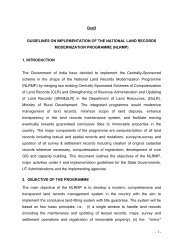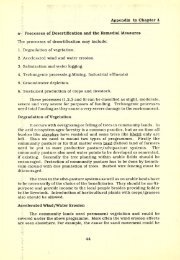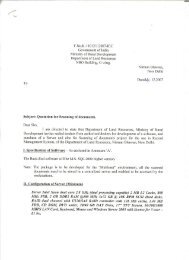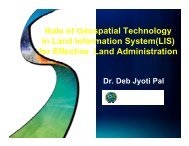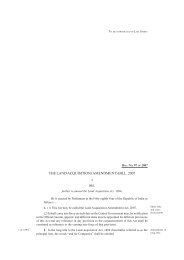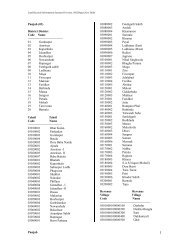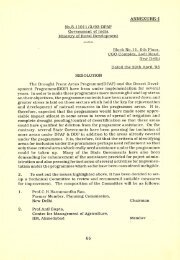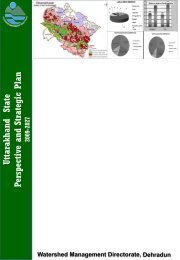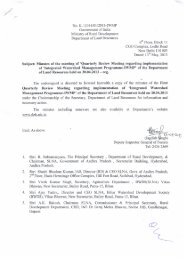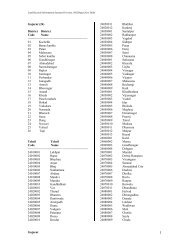Success Stories -AP - Final - Department of Land Resources
Success Stories -AP - Final - Department of Land Resources
Success Stories -AP - Final - Department of Land Resources
Create successful ePaper yourself
Turn your PDF publications into a flip-book with our unique Google optimized e-Paper software.
ANDHR<strong>AP</strong>RADESH
A.1. White Revolution: Amidalakunta prospers byincreasing milk productionAmidalakunta village is almost unrecognizable today. Situated around 10 Kms from theMandal headquarters in the Anantpur district <strong>of</strong> Andhra Pardesh, the small village <strong>of</strong>Amidalakunta is a centre <strong>of</strong> attraction for nearby villages. People from the neighborhoodfrequently come to Amidalakunta to learn from the villagers here. So, what has Amidalakuntagot?Other people are interested to know from the residents <strong>of</strong> Amidalakunta the secret behindthe change. Today, Amidalakunta produces around 1000 litres <strong>of</strong> milk each day. Around 180acres <strong>of</strong> land is now irrigated. The village has 18 graduates, four <strong>of</strong> whom are engineers andeight are B.Ed. Besides, there are two post graduates in computers. The average monthlyhousehold income increased to around Rs 8400.(Photo 1: Women SHG members in action)But the situation in the village was not always like this. Back in 2002, only 75 out <strong>of</strong> around940 acres in the village had irrigation facility. Anantpur district frequently receives erratic andvery low rainfall keeping the agriculture production low and forcing people to move out <strong>of</strong>their villages to look for work. Though the village had around 45 milch animals, theirproduction was only about 15 litres per day. There were no graduates in the village and none<strong>of</strong> the girls went to school. Households earned only around Rs 2000 per month on average.Most villagers borrowed regularly from the local moneylenders at very high interest rates andwere perpetually indebted as a consequence.Things began to change for the better when Andhra Pradesh Rural Livelihood Project(<strong>AP</strong>RLP) chose the village for a project for watershed treatment. Significantly, the Projectwas not just about soil and water conservation but it was equally about improving theagriculture productivity and livelihoods <strong>of</strong> the people.A key objective in the Project was to help the women <strong>of</strong> the village acquire new skills,develop capacities and take charge <strong>of</strong> their own as well as their families’ development.Towards this, all the women in the village were first helped to form Self Help Groups (SHGs).The seven SHGs thus formed were then federated into a higher order institution, the VillageOrganization (VO).2
(Photo 2: SHG meeting in progress)To get all the people in the village to participate in the Project, <strong>AP</strong>RLP held series <strong>of</strong> regularmeetings with all villagers in all hamlets. In order for the benefits <strong>of</strong> the Project to continueeven beyond the Project’s life, it was important that everyone in the village participates andcontributes to the Project.These meetings also served another important purpose as several ideas were generated bythe people. One such idea was to develop the livestock in the village as an alternate means<strong>of</strong> livelihood. <strong>AP</strong>RLP arranged training programmes on animal husbandry for the women inSHGs.After the successful completion <strong>of</strong> the training, <strong>AP</strong>RLP with the technical help from the localveterinary department helped the SHGs to purchase 25 cows <strong>of</strong> jersey breed. Each SHGreceived two to three cows. The purchase was entirely funded through a loan from thelivelihoods funds in the Project.Regular animal health camps were conducted in the village to ensure animal health andbreed improvement. CO1 and napier grasses were grown to improve the fodder availabilityin the village itself.(Photo 3: Improved fodder availability)The Project got a person from the village trained in basic animal husbandry and veterinarycare. The person was called as the veterinary para worker and looked after the health <strong>of</strong> theanimals and extended first aid. A veterinary medicine kit was also provided to the para-3
time and inputs. This also shows the increasing premium that the villagers are putting ontheir time. The VO has so far earned Rs.13000 from the visiting villagers and this money isused as revolving fund to extend loans to SHG members.(Photo5: Improved livelihood opportunities)The improved financial situation and the confidence <strong>of</strong> the VO is reflected in theircontribution <strong>of</strong> Rs.40,000 for construction <strong>of</strong> a reservoir for the drinking water purpose. Italso shows their social responsibility and commitment towards the development <strong>of</strong> thevillage.5
A.2.From poverty to prosperity- the Watershed wayThe land in Guntimadugu village in Kadapa district <strong>of</strong> Andhra Pradesh is undulating whichwas leading to rapid erosion <strong>of</strong> soil due to speedy run<strong>of</strong>f <strong>of</strong> rain water. The once fertile landswere gradually turning infertile. On top <strong>of</strong> it, the area receives poor rainfall and the village didnot have adequate water harvesting structures to store whatever rain it received. Due to this,the ground water recharge was also very limited which in turn further reduced theproductivity <strong>of</strong> the land. The poor agriculture production and productivity also meant therewasn’t sufficient fodder being grown in the village. Because <strong>of</strong> this the production <strong>of</strong> milk wasalso too little to provide alternative livelihood options to the villagers. Around 20 per cent <strong>of</strong>the people from this village regularly migrated to towns and cities in the lean seasons lookingfor manual labour work.(Photo1: Before treatment)The state government started a watershed development project in Guntimadugu under theDrought Prone Areas Programme (DP<strong>AP</strong>). The Project adopted a ‘complete areadevelopment’ approach by taking up series <strong>of</strong> physical measures to arrest soil erosion,reducing run <strong>of</strong>f and increasing soil moisture. To check soil erosion, the Project built rock filldams, loose boulder structures, made earthen bunds and stone trenches across the slope <strong>of</strong>lands. To harvest and store the water from scanty rainfall DP<strong>AP</strong> constructed farm ponds,dugout ponds, sunken pits, check dams, gabion structures, percolation tanks and continuouscontour trenches. These significantly reduced the speed <strong>of</strong> run <strong>of</strong>f and consequently led toincrease in ground water recharge in the area. The groundwater table rose from 12 metresto seven metres. Further, silt was applied to agriculture lands.(Photo2: Gabion structure)(Photo3: Horticultre plantation)All these measures directly contributed to increase in soil fertility that in turn led to revival <strong>of</strong>agriculture in the village. An <strong>of</strong>f shoot <strong>of</strong> this was that farmers started growing fodder for thefirst time. To help farmers make the most <strong>of</strong> the opportunity, the Project provided them withCO1 and napier varieties <strong>of</strong> fodder grass. The production <strong>of</strong> milk gradually went up. To6
increase greenery as well as to provide additional income source to the villagers, 3 hectares(ha) <strong>of</strong> block plantation, 3 Kms <strong>of</strong> avenue plantation and 62 ha <strong>of</strong> horticulture plantations likemango were taken up in the area.Besides building physical structures, the Project also invested in strengthening village levelsocial institutions. Self help groups (SHGs) were formed and strengthened through variousmeetings and capacity building programmes. With time, these SHGs became activeparticipants in the watershed development activities in the village.The Project brought the intended benefits to the people in Guntimadugu. The increasedwater table and soil fertility helped farmers improve their incomes from agriculture. The areaunder multiple crop registered 100 per cent increase while there was a seven fold increasein area under horticulture crops. The increased fodder production almost doubled the milkproduction in the village to more than 200 litres a day, providing people with supplementaryincome. The improved income in the village resulted in checking <strong>of</strong> migration to towns andcities.The quality <strong>of</strong> life in the village improved, particularly for women as drinking water was nowavailable round the year in the village due to the water harvesting structures. SHGs whichwere primarily <strong>of</strong> women, helped them participate in making decisions in the village. Thetable below depicts some <strong>of</strong> the results form the Project.Pre and post watershed development situation in the villageItem Unit Pre Project Post-ProjectStatus <strong>of</strong> water table Mtrs 10 – 12 7 to 9No. <strong>of</strong> ground water structures rejuvenated Nos. - 20Availability <strong>of</strong> drinking water Months 8 -12 12Increasing irrigation potential Acres 1015 1250Area under single crop Acres 585 640Area under double crop Acres 365 485Area under multiple crop Acres 65 125Net increase in crop production area Acres 1015 1250Increase in horticulture crop Acres 25 180Increase in area under vegetation Acres 6 15Increase in fodder production / fire wood Acres 0 6Increase in milk production Litres 113 207No. <strong>of</strong> SHGs, coops and thrift groups Nos 4 10People below poverty line Nos. 246 208No. <strong>of</strong> migrating people Nos. 287 93Women participation in decision making Nos 0 9Source: External evaluation report, 2007In 2007, an independent external evaluation <strong>of</strong> the Project was carried out by an externalagency. The agency conducted a survey in the area and interacted with all the stakeholders. The agency assessed the qualitative impact through focused group discussions andpersonal interviews with the stakeholders while some impacts like increase in water table,increase in irrigation potential etc. were measured technically.7
Due to the significant change and overall prosperity that this watershed project brought inGuntimadugu village, it received the status <strong>of</strong> Model watershed. The ‘ridge to valley’treatment method was replicated in other watersheds as well. The government arrangedexposure visits for district <strong>of</strong>ficials and members <strong>of</strong> other watershed committees to enablethem replicate the best practices from this project in other areas. Indira, an SHG membersays that the watershed programme has saved their village from the devil called poverty andhas brought prosperity in the village. She says that hard work and true efforts <strong>of</strong> all thestakeholders is the key to success <strong>of</strong> this project. The villagers now feel proud <strong>of</strong> theirvillage.8
A.3.Budlapur: powered by organic cotton“Action is the foundation to success”Budlapur, a small village <strong>of</strong> Ranga Reddy district <strong>of</strong> <strong>AP</strong>, is known for its cotton production.Cotton is one <strong>of</strong> the main crops in kharif season in the area. Cotton, a highly sensitive crop,is prone to insects and pests. The farmers <strong>of</strong> the villages relied on chemical pesticides andinsecticides to save their crop. But with improved resilience <strong>of</strong> the pests and insects to thesechemicals, farmers were forced to spray higher doses more frequently each year. This wasleading to steep increase in cost <strong>of</strong> cultivation. On the other hand indiscriminate use <strong>of</strong>chemical inputs was reducing the soil fertility leading to a drop in the yields. The farmerswere very depressed with the decreasing yields and increasing costs. But they struggled t<strong>of</strong>ind a solution <strong>of</strong> the problem.An opportunity arrived in the village in the form <strong>of</strong> the watershed project under ‘Hariyali’guidelines <strong>of</strong> Government <strong>of</strong> India (GoI). Realizing the problem <strong>of</strong> the cotton farmers as anacute one, the Project decided to tackle it head on. It introduced the farmers to the conceptsand practices <strong>of</strong> integrated pest management practices and organic fertilizers. Farmers werealso encouraged to take up trap crops which control pests and insects in natural manner.These practices were less costly and were not harmful for soil. The farmers were thus ableto reduce the cost <strong>of</strong> cultivation for cotton and the crop started giving higher yields.(Photo1: A view <strong>of</strong> the young cotton crop in the project area)However, convincing the farmers to give up long years <strong>of</strong> established practice and replace itwith an unknown practice was not easy. The farmers by this time were very wary <strong>of</strong> takingany risk. But the Project gradually convinced the farmers who were members <strong>of</strong> user groupsand Village Organization (VO) to at least attend the training programmes on Integrated PestManagement (IPM). They were taken to places where IPM measures were ondemonstration. Seeing the practice in action convinced the farmers who returned to theirvillage and tried out the natural methods <strong>of</strong> pest control in their fields. The Projectestablished convergence with local agriculture department to help the farmers get subsidyfor IPM and organic farming practices.These interventions under productivity enhancement component <strong>of</strong> watershed programmebrought the desired results. Farmers stopped using chemical fertilizers like D<strong>AP</strong> andpesticides. They started the practice <strong>of</strong> deep ploughing for better soil and pest management.Due to the intervention, the cost <strong>of</strong> cultivation was reduced by 50 per cent and the yields9
increased to 5 to 6 quintals from 3 to 4 quintals per acre. The farmers were able to managepests and insects in an effective manner.Now K. Shankriya who grows cotton in two acres <strong>of</strong> land spends only Rs. 500 annuallyinstead <strong>of</strong> Rs. 6000 which he used to spend earlier, mostly on chemicals. He adoptednatural pesticides like neem kernel spray, cow dung and cow urine, and chilli-garlic pastes tocontrol pests. He also adopted trap crops like marigold to attract and trap the pests.(Photo2: A farming couple)V. Namya who owns four acres and grows cotton used to get pr<strong>of</strong>it <strong>of</strong> Rs. 3000 to Rs. 4000per acre. But by using IPM practices, he now earns a pr<strong>of</strong>it <strong>of</strong> Rs.7000 per acre.Pochamma who owns two acres <strong>of</strong> land and grows cotton, earlier used to get a yield <strong>of</strong> onlythree quintals per acre. After using neem and cow dung based natural pesticides, deepploughing and using castor as a trap crop, her cost <strong>of</strong> cultivation is reduced by 50 per centand the yields have increased to 5 – 6 quintals per acre.On the whole, the experience in the Project suggest that use <strong>of</strong> organic fertilizers andmethods like IPM increased the yield <strong>of</strong> cotton by 50 per cent and reduced the cost <strong>of</strong>cultivation to around Rs 2000 per acre from Rs.6000 per acre. In terms <strong>of</strong> quality, the colourand filling <strong>of</strong> the cotton ball improved fetching the farmers a better price for the same yield.Now the farmers from Bramanpally and other nearby villages come to see and learn thepractices adopted by Budlapur farmers.Raju, a technical <strong>of</strong>ficer for Budlapur watershed project says, “You see, in life, lots <strong>of</strong> peopleknow what to do, but few people actually do what they know. Knowing is not enough! Youmust take action”.10
A.4.Transformation <strong>of</strong> Majeedpur“Look for the good in every situation. You'll almost always find it”. This statement holds verytrue for Majeedpur village in Shameerpet mandal <strong>of</strong> Andhra Pradesh. The story <strong>of</strong>Majeedpur is the story <strong>of</strong> rejuvenation, a story <strong>of</strong> transformation <strong>of</strong> an erstwhile aridlandscape to one with tanks full <strong>of</strong> water. This transformation began in the year 2000-01under the Integrated Watershed Development Programme (IWDP).The lack <strong>of</strong> water meant large tracts <strong>of</strong> agriculture lands were left fallow every year in therabi season. Moreover, as the land holdings are fragmented the crop yields in the villagewere much lower than the other villages in the mandal. The fragmentation was so severethat the maximum single cultivable unit was not more than 0.5 acres. Fortunately for thevillagers, their proximity to the capital city <strong>of</strong> Hyderabad meant they were able to findsufficient manual labour work which was more remunerative than agriculture.Ironically Majeedpur was dry and lacked water despite there being two old tanks in thevillage. The reason was that the tanks were breached and feeder channels were in disrepairand <strong>of</strong> no use in the village. The key objective therefore in the IWDP project was to restorethese tanks which had the potential to meet the water requirements <strong>of</strong> the village.During the planning stage various strategies were discussed with the people <strong>of</strong> the village. Itwas then decided to convert the two old tanks; Gidde Kunta and Hanmandla Kunta intopercolation tanks. The watershed project repaired the breached regulatory channel <strong>of</strong> theGidde Kunta tank. The bund that had severely eroded was also repaired. The tank wasraised to a height <strong>of</strong> five metres (m) and its length extended to 80 m. New sluice gates werefitted giving the old tank a completely new make over as percolation tank.Hanmandla Kunta, another tank which was not having natural catchment area, got waterdiverted from near by Venkateshwarla Gutta by constructing an 85 metre long wall on sheetrock and digging trench for 30 m. The bund <strong>of</strong> this tank was strengthened and extended.Besides the two tanks, Devuni Bhavi, one <strong>of</strong> the ridges in the village was also rejuvenated.These restoration works had a very significant impact, both on the tanks and the villageitself. The capacity <strong>of</strong> Gidde Kunta increased to one lakh cubic metres. Now, it is the onlysource <strong>of</strong> drinking water for cattle <strong>of</strong> three villages - Majeedpur, Rajabollaram and Pudur.The tank is filled by first rain resulting in ground water increase in an area <strong>of</strong> about one sq.K.m.Photo1: Gidde Kunta Percolation TankAt the same time the capacity <strong>of</strong> Hanmandla Kunta increased to 0.80 lakh cubic metres.The ground water significantly increased in an area <strong>of</strong> about one sq. K.m. range. It is also11
[[[[source <strong>of</strong> drinking water to cattle in the village. The rejuvenation <strong>of</strong> the old Devuni Bhaviridge also helped improve the ground water recharge.Photo2: Hanmandla kunta Percolation TankAs a result <strong>of</strong> this intervention, ground water table in Majeedpur improved by two metres.The restored tanks changed the cropping pattern in the village. Previously where farmerswere growing Maize and Jowar at a subsistence level, now vegetables and paddy are beinggrown. Villagers have now taken agriculture as an enterprise. Now they are takingadvantage <strong>of</strong> their proximity to Hyderabad to sell their agriculture produce at a good price.BEFOREPhoto2: Devuni Bhavi ridgeAFTERKrishna, a small farmer with two acres <strong>of</strong> land is cultivating green vegetables on his land.Earlier he used to go to Hyderabad daily in search <strong>of</strong> labour work. He says that he goes toHyderabad now as well but not in search <strong>of</strong> work but to sell his vegetables. He manages toearn about Rs. 250 per day from the vegetables, more than he would have earned as alabourer. He says, “We were blind and could not recognize the potential <strong>of</strong> our own land.”The farmers from nearby villages like Thimmaipally in Keesara mandal came to see thetransformation <strong>of</strong> Majeedpur. They too have realized the potential <strong>of</strong> natural resources intheir villages and have decided to conserve and improve those.12
Photo 4: Gidde Kunta & Hanmandla Kunta tanks (one with electric posts shown)13
A.5.Stabilizing Incomes and Developing Resiliencethrough WatershedA Case Study from Chittoor district, Andhra PradeshBisanatham-I watershed is located in Gudipalle mandal <strong>of</strong> Chittoor district in Andhra Pradeshalong the <strong>AP</strong>-Karnataka state border, about 16 kilometers from Kuppam town. There arethree habitations falling in this watershed, viz., Bisanatham, Athinatham andSalachintanapalli comprising a total population <strong>of</strong> 923. The population comprises <strong>of</strong> 14%Scheduled Castes (SC), 80% Backward Castes (BC) and 6% others. Majority <strong>of</strong> thepopulation was small and marginal farmers. The terrain was highly undulating, with redsandy soil. The livelihood situation was precarious for the mostly water-dependent agrarianpopulation due to water scarcity. Large scale migration was a common phenomenonoccurring due to lack <strong>of</strong> alternative livelihood options.The watershed development project was implemented from 1995 to 2001 – 02 withthe objectives <strong>of</strong> promoting economic development and restoration <strong>of</strong> ecological balance inthe area. Out <strong>of</strong> the total 1410 ha <strong>of</strong> the geographical area, 520 ha was treated with variousphysical works to augment land and water resources.To meet with the desired objectives, the key activities carried out included continuouscontour trenches, afforestation, check dams, percolation tanks and gully control worksadopting the ridge to valley approach.The Bisanatham watershed achieved excellentresults mainly due to a good combination <strong>of</strong>technical and social components. Thesecomponents were carried out by the communityadopting a well-thought out planning andimplementation strategy, while the implementingagency played the role <strong>of</strong> a facilitator.Fig 1: Changes in land use patternThe increased availability <strong>of</strong> soil moisture, surface and groundwater helped inexpanding land under cultivation (Fig.1) drawing from the fallows. <strong>Land</strong> productivity alsoincreased significantly. Diversification to more remunerative land use systems includinglivestock, horticultural and vegetable production improved sources and income levels whichled to poverty reduction <strong>of</strong> the rural poor and reduced labour migration.Photo 1 Percolation TankPhoto 2 Percolation tank14
Photo 3 CheckdamPhoto 4 Crop fieldThe percolation tank captured rainwater and recharged the ground water increasingwater levels in wells. Further, the check dams increased availability <strong>of</strong> stored water to beused as complementary irrigation during large dry spells while adding to ground water. Thus,the overall enhanced surface and groundwater helped in bringing more area undercultivation (Fig. 1) which was earlier lying fallow. 63% <strong>of</strong> the farmers, who left their landsfallow and worked as labourers, gradually started cultivating their lands due to enhancedwater availability. In addition to paddy and millets, vegetables, flowers and fodder were alsogrown by farmers which fetched them more returns thereby enhancing their income levelssignificantly by 2009 – 10 (Fig.4). Changes in the land use pattern, production and incomelevels from different sources are evident from the graphs.Fig. 2: Increase in Agriculture productionFig 3: Increase in Milk ProductionThere was considerable extent <strong>of</strong> common land in the watershed area, which wascritical to the non farmers as well. Afforestation and soil and water conservation activitieswere taken up on 800 acres <strong>of</strong> common land along the ridge area resulted in increase <strong>of</strong>biomass thus providing fodder security to the livestock. In normal years, the fodder fromcommons was available in addition to agricultural crop residue fodder. Increase <strong>of</strong> biomassalso helped in reducing soil erosion thus avoiding loss <strong>of</strong> fertility.15
Photo 5 <strong>Land</strong>scape before watershed projectPhoto 6 <strong>Land</strong>scape after watershed projectImproved natural resource regime including soil moisture and fodder availability helped instabilizing the income <strong>of</strong> the watershed inhabitants through agriculture and animalhusbandry. Many farmers also diversified into milk business while a few entered into settingup local enterprises.BEFORE WATERSHED PROJECT2009/10.Cash income from milk sale emergedas a major resilience measure for farmers tocope with uncertain rainfall conditions.There was a drastic decrease in bothoverall migration and duration <strong>of</strong> migrationcompared to the pre-watershed scenario.Earlier, 65% <strong>of</strong> the farmers used to migrateand used to work as agriculture labour; interms <strong>of</strong> duration, this reduced from severalmonths to a couple <strong>of</strong> months during 1995 andFig 4: Increase in Income levelsNow farmers have started makinginvestments in agriculture to buy crop inputsand machinery from their enhanced income.These include purchase <strong>of</strong> seeds, fertilizersand manure, and hiring/purchase <strong>of</strong> farmequipment. Many farmers have also purchasedmilch animals.Photo 7: Lady with milch cowsThe drainage line, which once used to be seasonal, has now become perennial; thus,the ground water recharge too has enhanced. Voluntary social regulations continue to playtheir role in protecting the resource. Before this programme only one bore well was drilled inthe catchment area <strong>of</strong> Peddavanka and found to be a failure. But after watershedintervention 21 bore wells were drilled and found all 21 Borerwells success. In addition tothis 43 formers are using surface water through centrifugal motors from the check dams. Thestream is not at all drying during summer season as well. 121 Acres <strong>of</strong> land belonging to 62farmers was brought under cultivation.16
Photo 8 CheckdamPhoto 9 stream<strong>Land</strong> use pattern and cropping pattern have witnessed positive changes due to theincreased water regime. Farmers are able to cultivate two crops, kharif and rabi. In addition,they have also started growing vegetables, mulberry, flowers etc.Plantation on common land has turned out be an asset for the Gram Panchayat.Money generated through sale <strong>of</strong> plants from common lands is used for public welfareactivities. For example – Rs.52.000/-, which were realized from auction <strong>of</strong> plants at commonland were utilized to construct concrete road in Athinatham habitation <strong>of</strong> BisanathamWatershed.Photo 10 : Concrete roadProper rules and regulations, framed by the watershed committee to protect commonresources, are being followed even after the watershed project is completed.Community has reposed its faith in the Chairman because <strong>of</strong> his honesty andcommitment. The benefits accrued to farmers and non farmers helped the Chairman gettingelected twice as the village Sarpanch.This documentation is based on sampled data collected for evaluating the successthrough different sources such as the agency records, transect, focused group discussions,and random sample 1 household survey. Improvement in the livelihoods throughdevelopment <strong>of</strong> natural resource condition, stabilized incomes and enhanced productivity, allpoint towards the success <strong>of</strong> the watershed program. Development <strong>of</strong> commons as part <strong>of</strong>watershed strategy took care <strong>of</strong> exclusion problems, in addition to reducing women’sdrudgery in collecting fodder. Cash flow due to milk income and vegetables, flowers etc.enhanced the coping capacity <strong>of</strong> both farmers and non farmers.1 10% <strong>of</strong> the beneficiaries have been covered under sample survey17
Continued protection and management <strong>of</strong> natural resources and the assets createdby respecting the rules and regulations framed during project period indicates sustainability<strong>of</strong> the project. Enterprise promotion such as dairy has helped build resilience to droughtconditions.18
A.6.Barren to FertilityWhile there's life, there's hope!"A great pleasure in life is doing what people say you cannot do." It was the only motivatingstatement for facilitators <strong>of</strong> watershed project at Ragolu, a small village <strong>of</strong> Gurla mandal <strong>of</strong><strong>AP</strong>, as the villagers were very pessimistic about the project. But gradually throughcontinuous persuasion by the implementers and exposure visits to other successfulwatershed areas, villagers were ready to take up the project with confidence.Ragolu is surrounded by hills on three sides and situated at the foot <strong>of</strong> the hills.During rainy season the rain water with high velocity <strong>of</strong> run <strong>of</strong>f used to bring tons <strong>of</strong> smallrocks and soils from the hills and due to high gradient percolation <strong>of</strong> water to the ground wasnegligible. At the same time it also caused erosion <strong>of</strong> top fertile soil which gradually turnedthe land into a degraded barren land. People lost faith in agriculture and started migrating insearch <strong>of</strong> livelihoods.At this juncture, with an objective to control the run<strong>of</strong>f, soil erosion and there byincreasing the percolating capacity to increase the ground water level and fertility <strong>of</strong> soil andto enhance livelihoods, the interventions <strong>of</strong> watersheds were launched under IWDP inRagolu.The Planning process for the project wascarried out through Participatory Rural Appraisal.The process involved the villagers and thepanchayat members in the transect walk foridentification <strong>of</strong> the interventions to be taken up.The interventions were planned in tune with thedesired objectives keeping in view the ‘Ridge toValley’ concept.Photo 1: Planning through PRAAt the foothill <strong>of</strong> hillocks continuous contour trench <strong>of</strong> 1000 mts was executed. Toarrest the soil erosion in the first order streams, loose boulder structures and Percolationtank were constructed. Due to the above structures the soil moisture had been increased tooptimum levels. Apart from this 20 small check dams were constructed in the third orderstreams to avoid the soil erosion and to improve the ground water level in the catchmentarea.Photo 2: Loose boulder Check dam Photo 3:This also facilitated the increase in the water levels in the surrounded Wells. Apartform the above interventions, horticultural plantations were encouraged and saplings were19
distributed to the villagers. Teak and other plantations were taken up in the fields as well ason the bunds <strong>of</strong> the fields. Mango and cashew plantation in 45 hectares were taken up.With all the above interventions there was remarkable improvement in the lives <strong>of</strong> thevillagers in terms <strong>of</strong> housing, food and children education.Photo 4 Photo 5Horticulture Plantation done under the projectB. Sreeramulu, a farmer having 4acres <strong>of</strong> land, explained that before thewatershed interventions, there was no watersource. There used to be no scope for anykind <strong>of</strong> agricultural practices. But with theinterventions he was able to get good yield.He said that the check dam shown in thepicture alone was catering the needs <strong>of</strong>nearly 60 acres <strong>of</strong> land around and the cattlein the village. Prior to the construction <strong>of</strong> thesaid check dam, people used to walk up to 5km for catering the cattle needs. He proudlyclaimed that, he was getting 600 boxes <strong>of</strong>Mango yield which got him around Rs.1 Lakhper annum.Photo 6: Check dam under the projectM. Narasinga Rao, a small farmer owing 2.5 acres <strong>of</strong> land says the teak plantwhich he planted on the bund <strong>of</strong> his field in the past, gave him the good quality wood and hemade a double bed cot with the same and presented to his daughter in her wedding. Healso told that he had sold cashew crop for Rs.30,000/- for a year.The orchards, farm pond and other structures constructed in the farmers’ fields arebeing maintained by the individual farmers and the structures such as check dams andothers which were common for all are being maintained by the land holders around the saidstructures called as user groups.The village has become center for attraction for the near by villages. People fromnear by area come to see how Ragolu, a village cursed with barren land, has turned itsbarren land into fertile. They say “It is only through labor and painful effort, by grim energyand resolute courage, we move on to better things”. The same kinds <strong>of</strong> interventions arebeing planned for other watershed projects in the district.20
A.7.<strong>Land</strong>, Water and Livelihoods!!!Ginjeru village is located at 18 km west <strong>of</strong> Vizianagaram district <strong>of</strong> AndhraPradesh. The soils are red and sandy with pebbles. Low level <strong>of</strong> ground water table andinfertile lands due to erosion produce very low yield <strong>of</strong> crops. There were hardly any wageopportunities available in the village. If at all any <strong>of</strong> the villagers found wage labor, he usedto get 40 or 50 rupees for whole day <strong>of</strong> work. In this condition the last option that villagersare left with is migration.“If we don't start, it's certain we can't arrive.” With this thought Ginjeru was takenup under IWDP for watershed intervention. The Water was to be conserved right from thesource. Planning for the project was done with peoples’ participation. Villagers as well asthe pancayat representatives were involved in identification <strong>of</strong> works/interventions to betaken up in the project.Various natural resource management (NRM) activities like peripheral trenches(1.45 Kms), rock fill dams (35), gabion structures (1), check dams (24), percolation tanks(12) and farm ponds (25) were taken up in the area for soil and water conservation.Photo 1: Rockfill damPhoto 2: CheckdamConstruction <strong>of</strong> the soil moisture conservation and water harvesting structuresremarkably increased the ground water level and fertility <strong>of</strong> the land. With increased fertility<strong>of</strong> land yields also increased significantly which ensured higher income to the farmers. Apartfrom construction <strong>of</strong> NRM structures, afforestration was done with eucalyptus, casuarinas,teak, mango, sapata and other plants.Under productivity enhancement component <strong>of</strong> the project foundation seeds for drycrops were promoted to increase production. Integrated nutrient and pest managementpractices were introduced to the farmers to reduce the cost <strong>of</strong> cultivation and enhanceproductivity <strong>of</strong> land. Fodder plantation (CO1 grass) and breed improvement programmethrough artificial insemination were also taken up to increase milk production in the village.Revolving funds were given to SHGs for livelihood and enterprise promotionparticularly for landless and marginal farmers. Through this revolving fund various livelihoodopportunities and micro enterprises like vegetable vending, tailoring, carpentry, basketmaking, fishing etc. were taken up. These activities helped significantly in improving socioeconomic conditions <strong>of</strong> the villagers.21
Vegetable vending: Group Name :Siva Parvathi Leader :Gedela Asiramma Members : 10 Each individual in the group is getting amonthly income <strong>of</strong> Rs.1500/- as againstRs.900/- previouslyPhoto 3: Vegetable vendingTailoring: Group Name : Kanaka Durga Leader : L.Sanyasamma Members : 10 Each individual in the group isgetting a monthly income <strong>of</strong>Rs.1350/- as against Rs.900/-previouslyThe Group used to commute toVizianagaram to work as tailoringassistants. But now with therevolving fund received as loan fromwatershed they have establishedtheir own tailoring equipment in theirvillage and their income level hasincreased.Photo 4: Tailoring by youthCarpentry: Group Name : Dayamaya Leader : L.Thavudu Members : 10 Each individual in the group is getting a monthlyincome <strong>of</strong> Rs. 1800/- as against Rs.1400/-previously The Group used to work as assistants tocarpenters and now with the revolving fundreceived as loan from watershed they haveestablished their own carpentry work shops.Photo 5: Carpentry by youthBasket Making:Villagers used to take loan from private financiers @ 30% PA to procure the raw materialand were forced to sell the product to the middle men at Rs.3/- per basket but now loanis available at meager interest @ 8% and the baskets are being sold directly in themarket @ Rs. 5/- per basket.22
Fishery:Besides life saving irrigation and recharge <strong>of</strong> ground water, farm ponds are being usedas fish ponds which give Rs.7000 net income per year to the farmers.Photo 6: a good catch <strong>of</strong> fish in the pondAn evaluation study (2009) for the project was taken up by an external agency toevaluate the impact <strong>of</strong> the project. The observations were carried out by comparing existingand pre watershed intervention situation by using various methods such as case studies,observations, interviews and other qualitative and quantitative methods.The study highlighted that due to the watershed intervention water level in wellsincreased by 2 Mts and agriculture productivity increased by 18% in the area as 80 Ha <strong>of</strong>additional area was brought under cultivation. Milk yield was increased by 125 Ltrs per day.The study showed that due to intervention <strong>of</strong> this project migration <strong>of</strong> 700 laborers waschecked. The overall income <strong>of</strong> the village was increased by 50%. The impacts <strong>of</strong> the projectwere evident in other important facets like education, health and nutrition status, sanitationetc. due to awareness among villagers, change in food habits etc.The villagers now understand that they have to work together to make the impactsustainable. The user groups and SHGs worked out their long term planning for utilization <strong>of</strong>watershed development fund to make sure that the growth engine <strong>of</strong> the village keepsrolling."Self-trust is the first secret <strong>of</strong> success." And it was the self trust <strong>of</strong> the villagers andfacilitators that made this change happen at Ginjeru.23
A.8. Gender Role in Watershed Development– A Case Study from Anantapur District, Andhra Pradesh.Introduction:More than 2/3 rd <strong>of</strong> the total land area <strong>of</strong> Andhra Pradesh can be classified as dry landwith an annual rainfall <strong>of</strong> less than 800mm. The DP<strong>AP</strong> has been under implementationsince 1970-71 onwards¹. Under this watershed development programme, lot <strong>of</strong> money hasbeen invested every year on activities like land reclamation or levelling, and soil & moistureconservation activities. However, social justice and equity was lacking in the process <strong>of</strong>planning and implementation <strong>of</strong> various activities in the watersheds, as the guidelines forimplementation do not provide any preferential treatment to the lands owned by thedisadvantaged sections. The participation <strong>of</strong> women has been generally absent or verymeagre in the planning and implementation <strong>of</strong> various watershed developmental activities².Background:Geographic location:Anantapur District lies between 13°- 40’ & 15°-15’ North Latitude and 76°-50’ & 78°-30’ East longitude and it ranks second in India in terms <strong>of</strong> lowest rainfall received, with anaverage annual rainfall <strong>of</strong> 552 mm as against the state average <strong>of</strong> 940 mm. Analysis <strong>of</strong> past100 years show that 70 years were drought hit and due to over exploitation <strong>of</strong> groundwater,the water table below ground level is now more than 20 m in the southwestern parts, 11 min the central and 22 m in the northwestern parts <strong>of</strong> the district.Natural resources development schemes:To combat the recurring drought and to bring comprehensive development, theDP<strong>AP</strong> programme was introduced in 1975 covering all the blocks in the district. In 1994-95,DP<strong>AP</strong> was converted to DDP on account <strong>of</strong> the agro-climatic conditions existing in thedistrict. The natural resources development works are being taken up by watershedcommittees, and user groups under the supervision <strong>of</strong> watershed development projectimplementing agencies and multi-disciplinary teams.So far, 813 watersheds are under implementation covering 838 habitations out <strong>of</strong>3426 habitations in the district. Major objectives <strong>of</strong> each watershed development project isto promote economic development and restoration <strong>of</strong> ecological balance. Special emphasisis on resource-poor and the disadvantaged sections <strong>of</strong> the watershed community such aswomen through greater access to income generating opportunities and focus on theirhuman resources development.About the area <strong>of</strong> study:The area <strong>of</strong> study is the “Mallapuram Watershed” under Kalyanadurg Mandal <strong>of</strong> theDistrict having 248 households with a caste composition <strong>of</strong> 509 BC, 13 OC and 127 SCmembers. A total <strong>of</strong> 2224.79 acres <strong>of</strong> land has been under cultivation out <strong>of</strong> which 1820acres is under dry land agriculture while 230 acres is under horticulture. Twelve womenself help groups, and one youth association are existing in the village. Groundnut,Redgram, Sunflower & Paddy are the major crops.A brief history <strong>of</strong> the watershed development programme in the village:The watershed project was sanctioned in the year 1996 under EAS scheme by theDDP and a NGO called RDT was involved as PIA in facilitating and implementing theprogramme. Simultaneously, SHG formation also was undertaken and a watershedcommittee was formed with 15 SHG women as part <strong>of</strong> the committee consisting <strong>of</strong> 22members.24
Objectives:Watershed programmes should move from purely land based development to arange <strong>of</strong> activities that provide opportunities for development <strong>of</strong> women and landless poor.CPR development is critical; equity and gender are most important issues to be addressed.Human beings are born as female or male, but learn to be girls and boys, and in turngrow into women and men. This learned behaviour is what makes gender identity, anddetermines gender roles.Since women are the last among the poorest, women’s situation has to be classifiedin 2 ways: the social condition and the social position <strong>of</strong> women. The work contribution <strong>of</strong>the women on an average is 55% more than that <strong>of</strong> the men in low-income areas and 75%<strong>of</strong> women’s work is in un-paid activities which are not economically rewarded. Womenadjust their work patterns to accommodate their specific environments and family needs.Deforestation, overgrazing, soil erosion etc., result in depletion <strong>of</strong> fuel wood, fodder andwater. These changes result in increase <strong>of</strong> time and energy <strong>of</strong> women for collecting water,fuel wood & fodder. Women work for longer hours than men and carry a disproportionateshare <strong>of</strong> burden to cope up with poverty.Certain major ailments engulfing these poor women are: lack <strong>of</strong> land ownership(entitlements), credit & capabilities, low degree <strong>of</strong> autonomy, low literacy, lack <strong>of</strong> newproductive skills and suitable technologies etc.Study <strong>of</strong> role <strong>of</strong> women in the society in context to watershed.It is proposed to study the position <strong>of</strong> women at house hold level & village level coveringvarious social, economic & ecological concepts in Mallapuram watershed village <strong>of</strong>Kalyanadurg Mandal. The study aims at:Identifying the needs <strong>of</strong> women with specific reference to available natural sources.Setting the objectives <strong>of</strong> the watershed project based on the needs <strong>of</strong> women topromote a fairer society for both women and men.Accessing & controlling the resources by women.Analyzing the impact <strong>of</strong> works already carried out in the watershed.Role <strong>of</strong> women SHGs in watershed development.Role <strong>of</strong> external facilitation by the government <strong>of</strong>ficials and NGOs to have betterparticipation <strong>of</strong> women in watersheds.Evolution <strong>of</strong> the water shed.How it was before 1984!Mallapuram was like any other backward village in the drought prone district <strong>of</strong>Anantapur. There was no unity among the villagers. Political groups dominated the entirevillage. There were no community activities, no proper roads and no sufficientaccommodation in the school building. There was absolutely no say for the women andbankers were not willing to extend loans to Agricultural section as most <strong>of</strong> the farmers weredefaulters.What happened during 1984 to 1996?Social mobilization was started by the RDT and education was identified as a keyarea and an education committee was formed by conducting location wise meetings withwomen and men asking them to send their children to school and the committee wassuccessful in enrolling 49 children into school. An additional room was constructed bycollecting donations from the villagers with the financial assistance from RDT and throughShramdan. A community health worker Smt. Sarojamma was identified, trained and shestarted coordinating with ANMs & Anganwadi teachers. Institutional delivery and familyplanning were encouraged and SHGs were started.25
From 1996 onwards:The year 1996 was a watershed year in the village in the sense that naturalresources management activities were started under EAS watershed with RDT as PIA sincegood amount <strong>of</strong> social mobilization was already done by RDT in that village. Variousactivities and interventions were taken up in the villages and the women from watershedcommittee and SHG groups played a vital role in all these. One woman, Smt. G.Lingammawas elected as Watershed Committee Chairman and this has helped in creating moreaccess for the women to the resources, <strong>of</strong>ficials & NGO. Women took the men along withthem in their march towards development.Activities:Drinking water as entry point activity:With the help <strong>of</strong> WHIRL, India & RDT, trainings were given to women at householdlevel in the application <strong>of</strong> Alum & Tamarind for water treatment. As a result, the fluoridecontent <strong>of</strong> drinking water reduced from 1.65 PPM to 1.4 PPM.To provide drinking water facility to SC locality,an estimate costing Rs. 60,000/- was prepared and theNGO came forward to provide Rs. 40,000/- towardsentry point activity and SHG women went from houseto house to collect balance contribution <strong>of</strong> Rs. 20,000/-and the drinking water problem was solvedpermanently within a month. The collective action <strong>of</strong>the women solved a major problem in the village.Soil moisture conservation measures:Photo 2: Women involved in contour bundingPhoto 1: Water tank as entry pointactivitySoil bunding & field bunding activities were taken upthrough women user groups in 553 acres at a cost <strong>of</strong>Rs.5.9 lakhs and 239 rock fill dams were constructed inthe fields <strong>of</strong> farmers at a cost <strong>of</strong> Rs.2.13 lakhs duringthe year 1998. Between 1996 and 2002, a total <strong>of</strong> 1852acres were treated in a phased manner. Farmers hadsown glyricidia and pongamia on the field bunds.Totally, 315 nos. <strong>of</strong> rock fill dams were constructed tostop soil erosion.Water Harvesting Structures:Two additional checkdams were constructed in addition to the ones already existingat an estimated cost <strong>of</strong> Rs.2.55 lakhs.Barren Hill afforestation:Two barren hillocks devoid <strong>of</strong> any vegetation were treated (around 50 acres) bydigging CCT and seed dibbling on the mounds with seeds <strong>of</strong> glyricidia, pongamia andseetaphal. The women had contributed a lot in the above afforestation and a 3 Km. stretch<strong>of</strong> avenue plantation also was taken up.26
Horticulture:Photo 3: Women fetching water for PlantationArea under Mango has increased from 5 acres to 250 acres and the number <strong>of</strong>farmers undertaking horticulture has increased from 2 to 70. Orchards <strong>of</strong> Sapota (25 acres)and tamarind grafts (10 acres) also were undertaken.Vermiculture / Greenmanuring:Totally, 20 farmers had established vermiculture units and this compost was beingused for vegetable or horticulture crops.Photo 4: Dry <strong>Land</strong> HorticulturePhoto 5: Vermiculture training in progressNoticeable Changes in the Village economyIndependent livelihood activities:SHG group members with their savings and revolving fund extended by DRDAindependently took up independent livelihood activities like vegetable vending, fruit vending,petty shops, flour mill, STD booth etc.On-farm demonstrations:A demonstration package <strong>of</strong> practices and nutrient management for groundnut cropwas worked out and on-farm demonstration was conducted in the field <strong>of</strong> Smt. Lingammaand she used to explain about all the interventions like ploughing across the slope, seedtreatment with Dithane M-45, intercultivation with redgram and castor in 7:1 ratio, application<strong>of</strong> Trichoderma for controlling the fungal diseases, control <strong>of</strong> Tikka leaf spot, sowing <strong>of</strong> Bajra& Jowar in the periphery in a row etc., to reduce pest and disease incidence as well as tohave better moisture utilisation. These simple techniques were found to be very beneficialunder drought conditions and this has encouraged other farmers also to take up the aboveactivities.27
Photo 6: Crop DemonstrationMilk Cooperative Society:Some SHG members belonging to different SHGs formed a small milk producerssociety and elected a president, vice-president & secretary amongst themselves. Thiscommon interest group got involved in collection <strong>of</strong> milk from all the producers in the villageand sending the same to the chilling centre after conducting the fat test & fixing the price ina transparent way. Smt. K. Vasuramma who is the secretary <strong>of</strong> this society is supervisingthe entire milk procurement activity & money disbursement. Milk production has increasedfrom 60 litres a day to 300 litres.Fodder:The main fodder part in the village comes through crop residues and hay. As notmuch <strong>of</strong> importance was given to green fodder earlier women were oriented on importance<strong>of</strong> scientific feeding practices in addition to motivating the farmers to cultivate green fodder.Interventions such as supplying CO1 variety Jowar planting material for 15 members tocover around 3 acres and 75% subsidized PC-23 Jowar in about 2 acres, motivated thefarmers to go for allocating part <strong>of</strong> their land for green fodder cultivation. Stylosantheshamata seeds were broadcast on bunds to provide legume fodder.Communication <strong>of</strong> information:Information regarding latest technologies in Agriculture, Horticulture, Animalhusbandry etc., is first communicated to SHG leaders and VO by the WDTS/PIA and in turnthey communicate to farmers and other stakeholders.Training programmes:Women were linked to ANTWA training programme sponsored by Agriculture<strong>Department</strong> to know about the preferred economic activities and other sustainablelivelihoods. Training programmes on sheep rearing helped women in knowing aboutmaintaining proper ratio <strong>of</strong> ewes & rams to encourage cross-breeding so as to get morebenefits.Health:A health organizer has been appointed to bring awareness among women regardingthe importance <strong>of</strong> Vitamin A & Iron tablets, communicable diseases, dietary measures,family planning etc. Incidentally, 100% family planning has been achieved in this villagedue to the total involvement <strong>of</strong> SHG women.Fuel:All the 246 families have shifted to smokeless chullahs with 30% cost subsidy and 6families have established biogas plants also. Besides, 38 cooking gas connections weregiven by the DRDA to SHG Women under the state government sponsored Deepamscheme.28
Sanitation:130 latrines were constructed in the village and here also women played a major rolein implementing this programme successfully.Literacy:All the women have started sending their children to schools and even the drop outs(9 girls & 4 boys) were made to rejoin in the school.Other livelihood activities:Tailoring, basket making, mat weaving etc., were taken up and a sum <strong>of</strong> Rs.5000/-was given to each livelihood group as revolving fund.<strong>Success</strong> stories <strong>of</strong> WomenPhoto 7: Training in Basket makingEntrepreneurship capabilities <strong>of</strong> women – Taking the tamarind plantation on lease.A contractor used to reap rich benefits on the avenue plantation (from Mallapur toPalvai road) by taking lease <strong>of</strong> the 80 fully grown tamarind trees from R&B <strong>Department</strong>.One fine morning in the year 1999 saw the women belonging to 4 SHGs’ sittingtogether and taking a decision to bid for the tamarind trees in the auction held by R&B<strong>Department</strong> and they decided to invest the savings <strong>of</strong> all the 4 groups in case theysucceeded in the bid. Accordingly, Smt.Jayamma participated in the auction on behalf <strong>of</strong>all the four groups and she was declared as asuccessful bidder for an amount <strong>of</strong> Rs.40,000/-.The women shared the responsibility <strong>of</strong> carryingout the activities like watch & ward, harvesting,cleaning, drying, removal <strong>of</strong> seeds from thefruits, packing & marketing etc., The womencould get wage employment for 55 days besidesgetting a gross income <strong>of</strong> Rs.1,25,000/- and thenet pr<strong>of</strong>it has been worked out as Rs. 50,000/-.From that year onwards, it is these women whohave been emerging as the successful biddersin the auction.Collective strength <strong>of</strong> the women- A force to reckon with!Photo 8: Tamarind Plantation under LeaseA rich person encroached into the Masjid area which was a common property. Noact or village elder could stop him from pursuing the construction <strong>of</strong> a house there. Then itwas the turn <strong>of</strong> these women to register a protest with the local revenue <strong>of</strong>ficials & Districtcollector, and finally they succeeded in stopping the construction. This not only boosted themorale <strong>of</strong> the women but their efforts also were well recognized by the villagers.“When the Masjid encroachment was removed by us, our efforts were recognised bythe villagers and they started consulting us on several social issues” says K.Manoharammawith confidence while narrating the above incident.29
Solving the problems <strong>of</strong> <strong>of</strong> village washermen.5 Washermen families <strong>of</strong> the village had to walk down a distance at 3-5 km. forwashing the clothes and they were at the mercy <strong>of</strong> farmers for using the water fromagriculture borewells. They were in a dilemma as to whether to continue with their pr<strong>of</strong>essionor not.At this stage, the generosity <strong>of</strong> thewatershed committee was visible where onceagain the women in the committee prevailedover to take a decision to help the washermenby constructing a dhobhighat with an incentiveamount <strong>of</strong> Rs.45,000/- which they had got fromthe NGO on account <strong>of</strong> being the bestwatershed. The estimates were prepared forRs. 58,000/- and Rs.13,000/- came in the form<strong>of</strong> shramadan and a dhobighat with powerconnection and motor came up adjacent to abore well which was having water with highfluoride content.The above stories only reflect the increasing confidence and financial independence<strong>of</strong> the women in the village. “When my husband died in 1992, entire burden <strong>of</strong> running thefamily had fallen on me and I had to borrow money from money lenders at exorbitant rates <strong>of</strong>interest” recalls Smt. G.Lingamma, a SHG member. “After joining the Gandhi MahilaSangham in 1993, the situation changed and I no longer depend on the money lenders”explains this member who states that she has also helped several other women like her t<strong>of</strong>orm into SHGs.“All eligible women in the village have undergone family planning operation and all ourchildren are sent to school which has been only possible due to our collective efforts” saysanother SHG member C.Vasuramma.Several other women belonging to the watershed village express similar sentimentsand feel that the financial and social benefits that accrued to them is on account <strong>of</strong> theiractive participation in water shed programme and self help activities.Roles <strong>of</strong> various agenciesRole played by RDT:Photo 9: Dhobi GhatThe P.I.A. personnel played an important role in social mobilization, involving andempowering the women, carrying out capacity building programmes on technical,managerial and financial issues related to watershed implementation, animal husbandry,education, health, sanitation, formation <strong>of</strong> SHGs, strengthening <strong>of</strong> SHGs, formation <strong>of</strong> V.O.creation <strong>of</strong> awareness on various government schemes and programmes linkages t<strong>of</strong>inancial institutions & line departments, marketing arrangements etc. Exposure visits toweavers and farmers also were organised so as to adopt successful programmes.Role <strong>of</strong> the Government:DDP which is now called as D.W.M.A. has provided the much needed funding andguidance for proper watershed implementation and the multi disciplinary team membersprovided necessary technical help to the PIA. DRDA has extended necessary financialassistance in the form <strong>of</strong> revolving fund and facilitated bank linkages in case <strong>of</strong> womenSHGs. Time to time, training programmes on record maintenance and imparting new skillsor skill up gradation were conducted. Bankers also have extended full cooperation byextending loans to SHG women for pursuing various economic activities.This village has been chosen for enhancing livelihoods activities under completedwatersheds category under <strong>AP</strong>RLP through DWMA and various capacity buildingprogrammes have been planned and one <strong>of</strong> the youth belonging to the village has been30
trained as a para worker in Agriculture & Animal husbandry and he has been found to bevery useful to the farmers and women. An amount <strong>of</strong> Rs. 2.00 lakhs towards RevolvingFund to be extended to V.O. and rupees two more lakhs towards other livelihood activitieshave been earmarked for providing further financial assistance to women, artisans &landless labourers. Plans are drawn to encourage farmers to adopt micro irrigation methods(Drip & Sprinkler) under <strong>AP</strong>MIP so as to have better water utilisation and enhancement <strong>of</strong>productivity.Analysis <strong>of</strong> impact:Soil moisture conservation works resulted in increased groundwater availability, reducedsoil erosion and increased agricultural productivity. The quality <strong>of</strong> vegetables and fruitshas increased due to usage <strong>of</strong> vermicompost and nine farmers have established theirown vermiculture units.Diversion from groundnut to Horticulture has resulted in getting sustainable income and ithas also acted as an insurance against groundnut crop loss during drought years.On-farm demonstrations helped the farmers to know about improved agronomicpractices and adoption <strong>of</strong> the same.Women played a vital role in identification, prioritization and execution <strong>of</strong> all works andthe impact is effective since all the activities are carried out through participatoryapproach involving all sections <strong>of</strong> people like women, men, farmers, landless and wagelabour in the village.The collective social action <strong>of</strong> the women resulted in empowerment <strong>of</strong> women inachieving improved wage employment, improved agricultural productivity, enhancement<strong>of</strong> sustainable livelihoods, improved education, health & family planning, adoption <strong>of</strong> nonconventionalenergy resources to reduce drudgery etc.What next? Some <strong>of</strong> the future plans & ideas <strong>of</strong> the women:Construction <strong>of</strong> a small building for conducting meetings <strong>of</strong> SHGs.Establishing a Dal mill.Taking up value addition activities like Jam & Jelly making.Taking up pickle making as a group activity.Taking lease <strong>of</strong> mango and other fruit crops <strong>of</strong> farmers and earning some income.Training on certain activities like pickle making, preparation <strong>of</strong> mango Jam and Jelly,basket making, tailoring on new designs etc.,Value addition to tamarind by cleaning the pulp, packaging, storing in cold storage andmarketing at appropriate time to get more income.Further what needs to be done!Regular trainings have to be conducted on issues like wages equity, leadership qualities,gender sensitization and latest scientific technologies to provide sustainable livelihoods.Proper utilisation <strong>of</strong> opportunities under <strong>AP</strong>RLP and NGO sponsored watershed whichhave been under implementation from the year 2000 onwards has to be done.Traditional water bodies treatment, soil and moisture conservation works, planning thelivelihood activities have to be carried out in a phased and a meaningful way to utilise theavailable resources with the active participation <strong>of</strong> women and this would definitely resultin more significant development <strong>of</strong> the village.31
Abbreviations:ANM : Auxiliary Nurse Midwife.ANTWA : Andhra Pradesh Training for women in Agriculture & Alliedactivities<strong>AP</strong>RLP : Andhra Pradesh Rural Livelihoods ProjectCCT : Continuous Contour TrenchesCPR : Common Property <strong>Resources</strong>DDP : Desert Development ProgrammeDP<strong>AP</strong> : Drought Prone Area ProgrammeDRDA : District Rural Development AgencyDWMA : District Water Management AgencyEAS : Employment Assurance ProgrammeMDT : Multi Disciplinary TeamPIA : Project Implementing AgencyR&B : Roads & Buildings <strong>Department</strong>RDT : Rural Development TrustSHG : Self Help GroupWHIRL : Water, Household and Rural Livelihoods32




